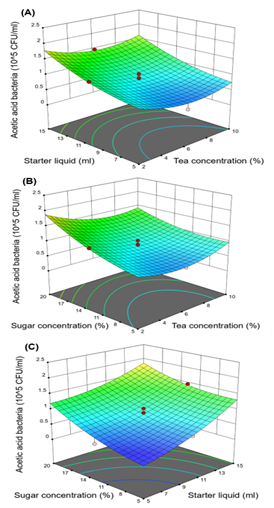Changes of Acetic Acid Bacteria and Yeast Concentration during Cocoa Bean Shell Kombucha Fermentation
Main Article Content
Abstract
Kombucha is a fermented tea that contains beneficial bacteria and yeast, which are good for health. This research aims to determine the biological properties that occur during the fermentation process of Kombucha from cocoa bean shell. The approach involves the experimental design and the development of a mathematical model employing Response Surface Methodology (RSM) with key factors: tea concentration (X1) ranging from 2% to 10%, starter liquid volume (X2) ranging from 5 ml to 15 ml, and sugar concentration (X3) ranging from 5% to 20%. The study also examines the fermentation duration and storage time in relation to the concentration of acetic acid bacteria and yeast. The results indicated that the most suitable condition were achieved with a 10% tea concentration, a starter liquid volume of 15 ml and a sugar concentration of 20%. A fermentation period of 7-10 days resulted in an acetic acid bacteria concentration was at 2.36x105 CFU/ml and the highest yeast concentration reaching 3.82x105 CFU/ml and a pH below 4 were suitable conditions for fermentation. Storing the Kombucha at room temperature and 4°C resulted in decreased concentration of acetic acid bacteria, yeast, and pH.
Article Details
References
นิสา ร่มส้มซ่า จุฑามาศ พรสันเทียะ ทิพย์วรินทร์ ริมลาดวน และกุณฑิกา เวชกลาง. (2564). คุณสมบัติทางชีวภาพของผลิตภัณฑ์คอมบูชาที่เกิดขึ้นในระหว่างกระบวนการหมัก. วารสารนเรศวรพะเยา, 14(1), 76-87.
สาวิตรี ลิ่มทอง. (2549). ยีสต์: ความหลากหลายและเทคโนโลยีชีวภาพ. (น. 611). กรุงเทพฯ: มหาวิทยาลัยเกษตรศาสตร์.
เอกชัย จารุเนตรวิลาส. (2558). อาหารฟังก์ชัน. อุดรธานี: มหาวิทยาลัยราชภัฏอุดรธานี.
Balentine, D. A. (1997). tea and health. Critical Reviews in Food Science and Nutrition, 37(8), 691-692. doi: 10.1080/10408399709527796.
Box, G. E. P., and Behnken, D. W. (1960). Some new three level designs for the study of quantitative variables. Technometrics, 2(4), 455-475. doi:10.2307/1266454.
Dufresne, C., and Farnworth, E. (2000). Tea, kombucha, and health: a review. Food Research International, 33(6), 409-421. doi:10.1016/S0963-9969(00)00067-3.
Haavik, H.I. (1974). Studies on the formation of bacitracin by Bacillus licheniformis: effect of glucose, Journal of General Microbiology, 81(2), 383-390. doi: 10.1099/00221287-81-2-383.
Ho, V.T, Zhao, J., and Fleet, G. (2014). Yeasts are essential for cocoa bean fermentation. International Journal of Food Microbiology, 17, 72-87. doi: 10.1016/j.ijfoodmicro.2013.12.014.
Kovacevic, Z., Davidovic, G., Filipović, J., and Popovic, A. (2014). A toxic hepatitis caused the kombucha tea – case report. Macedonian Journal of Medical Sciences, 7(1), 128-131. doi: 10.3889/oamjms.2014.023.
Martin, J.F., and Demain, A.L. (1980) Control of antibiotic biosynthesis. Microbiological Reviews, 44, 230-251.
Poveda, O.R., Pereira, L.B., Zeppa, G., and Stévigny, C. (2020). Cocoa bean Shell-A by product with nutritional properties and biofunctional potential. Nutrients,12(4), 11-23.
Subseree, J. (2009). DOE Central composite design. Retrieved June 4, 2016, from http://www.tpa.or.th/publisher/pdfFileDownloadS/FQ145_p72-74.pdf.
Vīna, I., Linde, R., Patetko, A., and Semjonovs, P. (2013). Glucuronic acid from fermented beverages: biochemical functions in humans and its role in health protection. International Journal of Recent Research and Applied Studies, 14(2), 217–230.
Vīna, L., Semjonovs, P., Linde, R., and Deniņa. L. (2014). Current evidence on physiological activity and expected health effects of kombucha fermented beverage. Journal of Medicinal food, 17(2),179-188. doi: 10.1089/jmf.2013.0031.
Watawana, M. I., Jayawardena, N., Gunawardhana, C. B., and Waisundara, V.Y. (2015). Health, wellness, and safety aspects of the consumption of kombucha. Journal of Chemistry, 2015(1), 1-11. doi: 10.1155/2015/591869.
Ziegel, E. R., Khuri, A., and Cornell, J. (1997). Response surfaces: Designs and analyses. Technometrics, 39(3), 342. doi: 10.1080/00401706.1997.10485140.


